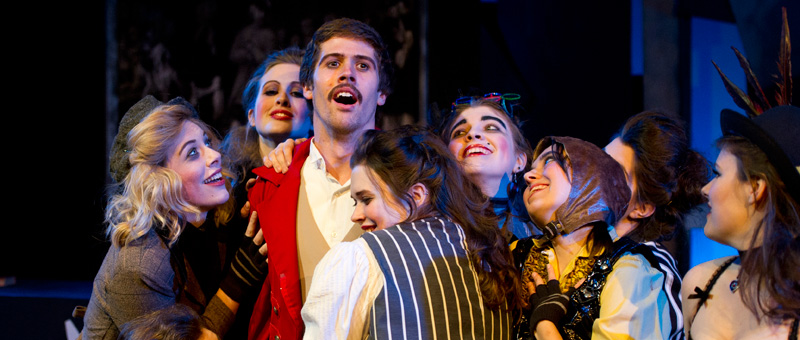
Most Recent Opera Productions:
| 2013 Spring Cendrillon | 2018 Fall Prima la Musica |
| 2013 Fall Suor Angelica / Curlew River | 2019 Spring Kiss Me, Kate |
| 2014 Spring Street Scene | 2019 Fall The Magic Flute |
| 2014 Fall Carousel | 2020 Spring Pirates of Penzance |
| 2015 Spring La Calisto | 2020 Fall Prospera's Island: An Operatic Fantasia/A Christmas Carol: A Staged Radio Play (virtual) |
| 2015 Fall The Child and the Magic Spells/Gianni Schicchi | 2021 Spring The Telephone/Hand of Bridge (virtual) |
| 2016 Spring The Marriage of Figaro | 2021 Fall Enchanted Pig |
| 2016 Fall Venus & Adonia/Dido & Aeneas | 2022 Fall Trouble in Tahiti/Gallantry: A Soap Opera |
| 2017 Spring Hansel & Gretel | 2023 Spring Cabildo/Cendrillon |
| 2017 Fall Acis & Galatea | 2023 Fall Into the Woods |
| 2018 Spring Little Women | 2024 Spring The Telephone and the Medium |
First Steps
Opera at Simpson had its humble beginnings when Mu Phi Epsilon, the music sorority on campus, decided to produce Kurt Weill’s Down in the Valley in the Spring of 1953. When this simple production lost its leading baritone, freshman Robert L. Larsen stepped in.
The next Fall, Mu Phi Epsilon elected to sponsor Gian Carlo Menotti’s two-year-old opera Amahl and the Night Visitors at Christmas, and chose Robert Larsen to direct it musically and dramatically. The sets were designed by Larsen and executed by students. Larsen played the piano in lieu of orchestra for the performances.
Larsen graduated from Simpson in 1956 and spent a year in graduate school at the University of Michigan. Upon completion of his studies he returned to teach at Simpson. He elected to do a full-length opera in February of 1958, of Menotti’s The Consul in the Little Theatre, a 200-seat facility on the college campus, with a remarkable student cast. As with performances of Amahl, Larsen played the piano, and continued to do so for all subsequent performances in the absence of an orchestra.
The Consul was a great success and initiated a tradition of performing one full-length opera each February for a number of years. Early productions included Johann Strauss’ Die Fledermaus and Mozart’s Così fan tutte in English.
Later milestones included Puccini’s Il trittico, Il tabarro and Gianni Schicchi. Mozart’s The Marriage of Figaro was performed in a lavish production that was designed for Hoyt Sherman Auditorium in Des Moines; and Donizetti’s Lucia di Lammermoor was performed in Italian.
Growth and Continued Success
A pivotal year was 1971-72 when the music department produced its last opera in the Little Theatre, La Bohème, and its highly anticipated first opera with orchestra, Britten’s Albert Herring. These were followed by the first opera in the new Blank Performing Arts Center, Die Fledermauswith orchestra. The production was a huge success. Larsen conducted, directed, and designed the entire show, and students built the set. In years following, the Theater Department at Simpson became an invaluable partner in designing and building sets for Simpson Opera
Having one production each year on stage with orchestra, and one in the studio theater with piano became standard at Simpson. Twentieth-century works were always a staple including Menotti’s The Medium, The Old Maid and the Thief, and The Saint of Bleecker Street, Britten’s Midsummer Night’s Dream and Albert Herring, Robert Ward’s The Crucible (first produced in 1966 with Ward attending), Carlisle Floyd’s Susannah, Thomas Pasatieri’s The Seagull, and Stephen Paulus’ The Village Singer (also with the composer in the audience). For some time, Christmas was celebrated with double-bill performances of Menotti’s Amahl and Humperdinck’s Hansel and Gretel, delightfully separated by a lavish dinner in the Great Hall.
In 1973, the Blank Performing Arts Center at Simpson College became the performance home of the newly founded Des Moines Metro Opera, as it remains to this day. In the early years of DMMO, Simpson musicians were an intrinsic part of the company’s structure, appearing as principals, comprimario singers, choristers, and orchestral players. As the company matured, it eventually became independent of the college, but still provided, and continues to provide, opportunities for aspiring students.
Throughout the years, Simpson Opera’s main-stage productions have included a wide variety of works including Franz Léhar’s The Merry Widow, Rodgers and Hammerstein’s Carousel, Jacques Offenbach’s Orpheus in the Underworld, Mozart’s The Magic Flute, and Giuseppi Verdi’s Falstaff. Larsen produced his final opera, Britten’s Albert Herring, in February of 2011.
Passing the Baton
In the Fall of 2011, upon Larsen’s retirement, a new chapter began in the history of Simpson College Opera. Bernard McDonald, a Scottish-born conductor with a professional background as a chorus master, coach, and pianist in international opera houses, was appointed Director of Opera and G. Dewey and M. Maine Larsen Chair in Opera. In the Spring of 2013 Massenet's Cendrillon was presented for the first time at Simpson, conducted by McDonald and directed by the first guest stage director in the program's history, Crystal Manich. Britten's Curlew River was staged for the first time in Fall 2013. In Spring 2014, Street Scene was directed by Mo Zhou and supported by a grant from the Kurt Weill Foundation.
A few years after that, Simpson Opera and Simpson Theatre started working together, but were still separate entities. Simpson Opera officially merged with Theatre Simpson in the 2019-20 academic school year and became Simpson Productions. It has been known as Simpson Productions ever since.
Simpson Productions embraces live performances in all forms including opera, new and classical plays, musical theatre, and non-traditional performances geared toward community engagement. By connecting the departments of music and theatre, Simpson Productions can offer students and audiences unique experiences that embody diverse performance modes. As we aim to provide our students multiple skills and life-changing experiences, we also hope to entertain, engage, and enlighten our audiences.